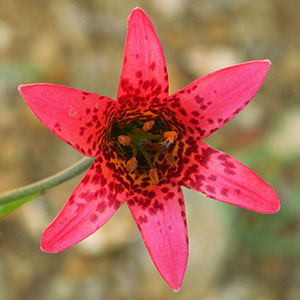Lilium humboldtii
Lilium bolanderi
Humboldt lily, Humboldt's lily
Bolander's lily
often somewhat purplish, variable, subrhizomatous to ± ovoid, 3.3–11.7 × 2.4–14.4 cm, 0.4–2.6(–3) times taller than long;
scales unsegmented or notched, longest 3.5–11.2 cm;
stem roots present or absent.
± ovoid, 3.5–7.9 × 2.6–5.3 cm, 0.9–2.1 times taller than long;
scales unsegmented, longest 3–5.7 cm;
stem roots absent.
to 3.1 m. Buds rounded in cross section.
to 1.1 m, glaucous.
rounded in cross section.
in 2–8 whorls or partial whorls, 3–16(–28) leaves per whorl, usually ascending, 4.6–14.5 × 0.8–3.6 cm, 2.9–7.2 times longer than wide;
blade usually ± oblanceolate, though often weakly so, rarely elliptic or lanceolate, margins usually undulate, apex acute;
veins and margins ± smooth abaxially.
in 1–5(–6) whorls or partial whorls, 3–19 leaves per whorl, ascending and often cupping stem, 1.8–7.1 × 0.7–2.8 cm, 2.2–4.8 times longer than wide;
blade ± obovate, oblanceolate, or occasionally elliptic, noticeably glaucous, margins nearly always undulate, apex widely acute;
veins and margins ± smooth abaxially.
racemose, 1–33(–40)-flowered.
usually umbellate in small plants, in large plants racemose or in 2 whorls, 1–9-flowered.
pendent, not fragrant;
perianth Turk’s-cap-shaped;
sepals and petals reflexed 1/5 along length from base, orange or yellow, with prominent red or magenta spots, not distinctly clawed;
sepals not ridged abaxially, 5.2–9.8 × 1.4–2.4 cm;
petals 5.6–9.6 × 1.5–2.9 cm;
stamens strongly exserted;
filaments parallel along most of length, then very widely spreading, diverging 17°–31° from axis;
anthers purple, 1.1–1.9 cm;
pollen rust, tan, or peach, becoming yellow or tan-yellow;
pistil 4.6–7.1 cm;
ovary 1.2–2.6 cm;
style green, often pale;
pedicel 7.8–21.2 cm.
nodding to horizontal, not fragrant;
perianth ± campanulate or funnelform;
sepals and petals somewhat recurved 3/5–4/5 along length from base, red or magenta, occasionally salmon pink or pale yellow, with maroon spots, often yellowish on proximal 1/3–1/2, not distinctly clawed;
sepals not ridged abaxially, 3.1–4.7 × 0.7–1.2 cm;
petals 3–4.5 × 0.7–1.1 cm;
stamens included;
filaments barely spreading, diverging 0°–12° from axis;
anthers reddish or magenta, 0.3–0.8 cm;
pollen rust, orange, or yellow;
pistil 2.1–3.5 cm;
ovary 1–2.1 cm;
style green, rarely reddish purple;
pedicel 0.8–14.2 cm.
longitudinally keeled, 2.5–5.4 × 1.8–3.3 cm, 1.1–2.3 times longer than wide.
2–4.1 × 1.2–2.1 cm, 1.4–3 times longer than wide.
not counted.
90–210.
= 24.
Lilium humboldtii
Lilium bolanderi
Subspecies 2 (2 in the flora).
Lilium humboldtii is declining throughout its range due to habitat destruction, primarily for housing. Forming large scattered colonies at foothill elevations under ponderosa pines or in oak canyons and chaparral, these massive plants with towering inflorescences and large flowers are quite striking. With Lilium pardalinum and L. parryi, they were used in the early part of the century to produce the Bellingham hybrid lilies, development of which continued with the Bellmaid hybrids. Though not as popular as various Asiatic hybrids, these are still in use.
A. M. Kellogg was aware as early as 1859 that the tall, orange-flowered, dry-land lily from the foothills of the Sierra Nevada was distinctive, and he presented this opinion to the California Academy of Sciences about that time (A. M. Kellogg 1872). By the time he had published a description attached to the name Lilium bloomerianum, P. E. S. Duchartre had described this same plant from material provided by B. Roezl and grown by M. Leichtlin, and named it after the German explorer and botanist Alexander von Humboldt. Carl Purdy and others then misapplied Kellogg’s name in various combinations to the southern California expression recognized here as Lilium humboldtii subsp. ocellatum.
The Humboldt lily is pollinated primarily by large butterflies, especially western tiger swallowtails (Papilio rutulus Lucas, family Papilionidae) and pale swallowtails (P. eurymedon Lucas), and to a lesser extent by the monarch butterfly [Danaus plexippus (Linnaeus), family Nymphalidae].
(Discussion copyrighted by Flora of North America; reprinted with permission.)
I. M. Johnston (1923) noted that Lilium bolanderi Watson was based on a mixed collection including L. kelloggii, and he argued that Watson intended the name to apply primarily to the latter species. Thus he proposed the name L. howellii for this diminutive, red-flowered, serpentine endemic. A. D. Cotton (1936) correctly concluded that Watson’s description applied primarily to the specimens here called L. bolanderi, and this view is now widely accepted.
Lilium bolanderi hybridizes with L. rubescens, L. washingtonianum subsp. purpurascens, and subspecies of L. pardalinum.
Bolander’s lily is primarily pollinated by Allen’s and rufous hummingbirds (Selasphorus spp., family Trochilidae).
(Discussion copyrighted by Flora of North America; reprinted with permission.)
1. Sepals and petals orange, spots magenta, without lighter red margins; bulbs off white, occasionally flecked with purple, scales always unsegmented; foothills of Sierra Nevada. | subsp. humboldtii |
1. Sepals and petals yellow or light orange, spots red or magenta, aureolated with lighter red margins; bulbs often purplish, scales usually notched; s California. | subsp. ocellatum |
